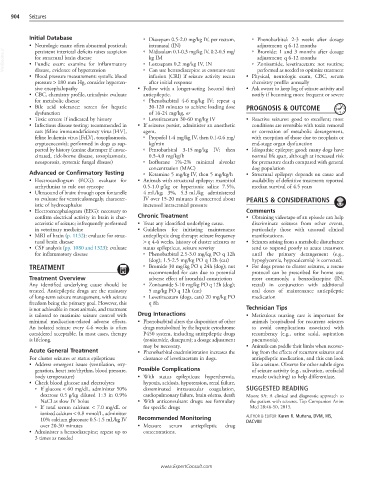Page 1806 - Cote clinical veterinary advisor dogs and cats 4th
P. 1806
904 Seizures
Initial Database ○ Diazepam 0.5-2.0 mg/kg IV, per rectum, ○ Phenobarbital: 2-3 weeks after dosage
adjustment; q 6-12 months
intranasal (IN)
• Neurologic exam: often abnormal postictal; ○ Midazolam 0.1-0.3 mg/kg IV, 0.2-0.5 mg/ ○ Bromide: 1 and 3 months after dosage
VetBooks.ir • Fundic exam: examine for inflammatory ○ Lorazepam 0.2 mg/kg IV, IN ○ Zonisamide, levetiracetam: not routine;
persistent interictal deficits raises suspicion
kg IM
for structural brain disease
adjustment; q 6-12 months
performed as needed to optimize treatment
disease, evidence of hypertension
infusion (CRI) if seizure activity recurs
• Blood pressure measurement: systolic blood ○ Can use benzodiazepine as constant-rate • Physical, neurologic exam, CBC, serum
pressure > 180 mm Hg, consider hyperten- after initial response chemistry profile: annually
sive encephalopathy • Follow with a longer-acting (second tier) • Ask owner to keep log of seizure activity and
• CBC, chemistry profile, urinalysis: evaluate antiepileptic. notify if becoming more frequent or severe
for metabolic disease ○ Phenobarbital 4-6 mg/kg IV; repeat q
• Bile acid tolerance: screen for hepatic 30-120 minutes to achieve loading dose PROGNOSIS & OUTCOME
dysfunction of 16-24 mg/kg, or
• Toxic screen: if indicated by history ○ Levetiracetam 30-60 mg/kg IV • Reactive seizures: good to excellent; most
• Infectious disease testing: recommended in • If seizures persist, administer an anesthetic conditions are reversible with toxin removal
cats (feline immunodeficiency virus [FIV], agent. or correction of metabolic derangement,
feline leukemia virus [FeLV], toxoplasmosis, ○ Propofol 1-4 mg/kg IV, then 0.1-0.6 mg/ with exception of those due to neoplasia or
cryptococcosis); performed in dogs as sup- kg/min end-stage organ dysfunction
ported by history (canine distemper if unvac- ○ Pentobarbital 3-15 mg/kg IV; then • Idiopathic epilepsy: good; many dogs have
cinated, tick-borne disease, toxoplasmosis, 0.5-4.0 mg/kg/h normal life span, although at increased risk
neosporosis, systemic fungal disease) ○ Isoflurane 1%-2% minimal alveolar for premature death compared with general
concentration (MAC) dog population
Advanced or Confirmatory Testing ○ Ketamine 5 mg/kg IV, then 5 mg/kg/h • Structural epilepsy: depends on cause and
• Electrocardiogram (ECG): evaluate for • Animals with structural epilepsy: mannitol availability of definitive treatment; reported
arrhythmias to rule out syncope 0.5-1.0 g/kg or hypertonic saline 7.5%, median survival of 4.5 years
• Ultrasound of brain: through open fontanelle 4 mL/kg; 3%, 5.3 mL/kg administered
to evaluate for ventriculomegaly, character- IV over 15-20 minutes if concerned about PEARLS & CONSIDERATIONS
istic of hydrocephalus increased intracranial pressure
• Electroencephalogram (EEG): necessary to Comments
confirm electrical activity in brain is char- Chronic Treatment • Obtaining videotape of an episode can help
acteristic of seizure; infrequently performed • Treat any identified underlying cause. discriminate seizures from other events,
in veterinary medicine • Guidelines for initiating maintenance particularly those with unusual clinical
• MRI of brain (p. 1132): evaluate for struc- antiepileptic drug therapy: seizure frequency manifestations.
tural brain disease > q 4-6 weeks, history of cluster seizures or • Seizures arising from a metabolic disturbance
• CSF analysis (pp. 1080 and 1323): evaluate status epilepticus, seizure severity tend to respond poorly to acute treatment
for inflammatory disease ○ Phenobarbital 2.5-3.0 mg/kg PO q 12h until the primary derangement (e.g.,
(dog); 1.5-2.5 mg/kg PO q 12h (cat) hypoglycemia, hypocalcemia) is corrected.
TREATMENT ○ Bromide 30 mg/kg PO q 24h (dog); not • For dogs prone to cluster seizures, a rescue
recommended for cats due to potential protocol can be prescribed for home use;
Treatment Overview adverse effect of bronchial constriction most commonly, a benzodiazepine (IN,
Any identified underlying cause should be ○ Zonisamide 5-10 mg/kg PO q 12h (dog); rectal) in conjunction with additional
treated. Antiepileptic drugs are the mainstay 5 mg/kg PO q 12h (cat) oral doses of maintenance antiepileptic
of long-term seizure management, with seizure ○ Levetiracetam (dogs, cats) 20 mg/kg PO medication
freedom being the primary goal. However, this q 8h
is not achievable in most animals, and treatment Technician Tips
is tailored to maximize seizure control with Drug Interactions • Meticulous nursing care is important for
minimal medication-related adverse effects. • Phenobarbital alters the disposition of other animals hospitalized for recurrent seizures
An isolated seizure every 4-6 weeks is often drugs metabolized by the hepatic cytochrome to avoid complications associated with
considered acceptable. In most cases, therapy P450 system, including antiepileptic drugs recumbency (e.g., urine scald, aspiration
is lifelong. (zonisamide, diazepam); a dosage adjustment pneumonia).
may be necessary. • Animals can paddle their limbs when recover-
Acute General Treatment • Phenobarbital coadministration increases the ing from the effects of recurrent seizures and
For cluster seizures or status epilepticus: clearance of levetiracetam in dogs. antiepileptic medication, and this can look
• Address emergent issues (ventilation, oxy- like a seizure. Observe for other subtle signs
genation, heart rate/rhythm, blood pressure, Possible Complications of seizure activity (e.g., salivation, orofacial
body temperature) • With status epilepticus: hyperthermia, muscle twitching) to help differentiate.
• Check blood glucose and electrolytes hypoxia, acidosis, hypotension, renal failure,
○ If glucose < 60 mg/dL, administer 50% disseminated intravascular coagulation, SUGGESTED READING
dextrose 0.5 g/kg diluted 1 : 3 in 0.9% cardiopulmonary failure, brain edema, death Moore SA: A clinical and diagnostic approach to
NaCl as slow IV bolus • With anticonvulsant drugs: see formulary the patient with seizures. Top Companion Anim
○ If total serum calcium < 7.0 mg/dL or for specific drugs Med 28:46-50, 2013.
ionized calcium < 0.8 mmol/L, administer AUTHOR & EDITOR: Karen R. Muñana, DVM, MS,
10% calcium gluconate 0.5-1.5 mL/kg IV Recommended Monitoring DACVIM
over 20-30 minutes • Measure serum antiepileptic drug
• Administer a benzodiazepine; repeat up to concentrations.
3 times as needed
www.ExpertConsult.com

